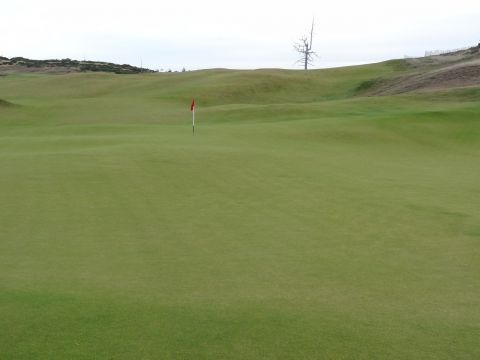This is the second part of a review of Old Macdonald Golf Club at Bandon Dunes. Text and photos by Scott Simpson
Putting greens are to golf courses what faces are to portraits
– C.B. Macdonald
If the fairways at Old Macdonald are supersized, then the greens are absolutely ginormous. Those that measure such things tell us that the Old Mac greens total 6.3 acres, topping the previous record holder, that aforementioned muni in the Kingdom of Fife (the reader may quickly tire of comparisons to the Old Course at St. Andrews, but there’s no avoiding it, especially as three of the holes are specifically modeled on Old Course templates). The green on No. 5, Old Mac’s Short hole, comprises some 20,000 square feet, and that’s on the shortest hole on the golf course (though, as with typical Macdonald short holes, the green is actually several different plateaus with a 9 to 10 foot elevation change, and the challenge is to hit the far smaller target). The measurement of the greens is amusing in itself, as I would challenge anyone to define where the aprons end and the greens begin, such is the seamlessness of the transition areas.
As the final step in the evolution of Team Keiser’s experience, Old Mac was the first course at Bandon Dunes seeded entirely in fescue. This was the subject of much debate and experimentation in building the original
The property itself is mostly flat, with the exception of two significant dunes lines. The most notable of these is a large dune separating the site from the Pacific Ocean (see below). The second formation is Back Ridge, a large dune line that runs almost the entire length of the Bandon property and serves as the western boundary of both Bandon Dunes and Pacific Dunes. Because the clubhouse needed to be located to the east of Back Ridge, near the road in a small flat section that now contains the first, second, 17th and 18th holes, the routing needed to move the players over and back in the course of play. This was accomplished imaginatively on the outbound trek by having the players launch their tee shots on the third hole, Sahara, over Back Ridge, with the most aggressive line dangerously close to a dramatic dead cedar tree.

Above, a group of golfers traverses Back Ridge in the early morning light after hitting their tee shots over the dune. The aggressive line comes close to the ghost tree, a distinctive dead cedar visible from most of the course.
From the top of Back Ridge the player gets his first view of the expansive bowl in which the bulk of the golf course is situated. The land initially appears flat, especially from a distance, masking dramatic undulations, which up close resemble nothing so much as an unmade bed. But it was a few days later, scanning Old Mac from the 14th hole at Pacific Dunes, that I saw why so many have compared it to the grounds of the Old Course. It has that same appearance of uniformity when you first scan the breadth of the valley, but any time you focus on a specific section of the course, the furrows and interesting landforms become evident. As I once noted long ago about the Old Course, it’s flat as the proverbial pancake, except inevitably for the specific spot on which your golf ball settles.

The view looking back from behind the third green, including the ghost tree on Back Ridge. Although any respectable drive leaves only a wedge in, the green is a staggering fifty yards deep. The lag putt may be the most important shot to have in your arsenal at Old Mac, but where does one practice 150 foot putts?
Next: Hole by hole assessment



